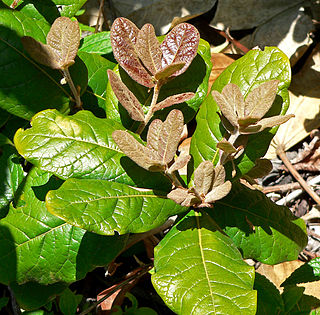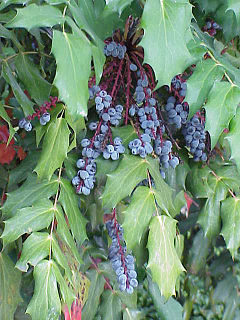
Milla, the Mexican star, is a genus of monocotyledonous plants in the family Asparagaceae, subfamily Brodiaeoideae. They are native mostly to Mexico, with one species extending into Guatemala, Honduras, Arizona, Texas and New Mexico.

Mahonia is a genus of approximately 70 species of evergreen shrubs and, rarely, small trees in the family Berberidaceae, native to eastern Asia, the Himalaya, North and Central America. They are closely related to the genus Berberis and botanists disagree on whether to recognize a separate Mahonia. Many botanists prefer to classify Mahonia as a part of Berberis because several species in both genera are able to hybridize, and because there are no consistent morphological differences between the two groups other than the leaf pinnation. However, recent DNA-based phylogenetic studies retain the two separate genera, by clarifying that unifoliolate-leaved Berberis s.s. is derived from within a paraphyletic group of shrubs bearing imparipinnate evergreen leaves, which are then divided into three genera: Mahonia, Alloberberis, and Moranothamnus ; a broadly-circumscribed Berberis would also be monophyletic.

Berberis, commonly known as barberry, is a large genus of deciduous and evergreen shrubs from 1–5 m (3.3–16.4 ft) tall, found throughout temperate and subtropical regions of the world. Species diversity is greatest in South America and Asia; Europe, Africa and North America have native species as well. The best-known Berberis species is the European barberry, Berberis vulgaris, which is common in Europe, North Africa, the Middle East, and central Asia, and has been widely introduced in North America. Many of the species have spines on the shoots and all along the margins of the leaves.

Berberis microphylla, common name box-leaved barberry and Magellan barberry, in Spanish calafate and michay and other names, is an evergreen shrub, with simple, shiny box-like leaves. The calafate is native to southern Argentina and Chile and is a symbol of Patagonia.

Mahonia repens commonly known as creeping mahonia, creeping Oregon grape, creeping barberry, or prostrate barberry, is a species of Mahonia native to the Rocky Mountains and westward areas of North America, from British Columbia and Alberta in the north through Arizona and New Mexico, then into northwest Mexico by some reports. It is also found in many areas of California and the Great Basin region in Nevada.

Quercus costaricensis is a species of oak native to Central America. It is often found with Quercus copeyensis in the upper montane forests, to 3100 meters elevation. The leaves are tough and leathery with a short petiole and toothed margin. Wind is the primary pollinator. Squirrels are their main seed predator but also their main disperser as they commonly lose their buried seeds.

Quercus xalapensis, or xalapa oak, is a species of oak in the red oak group. It is native to Central America and to Mexico as far north as Hidalgo and Sinaloa.

Podachaenium is a genus of Mesoamerican plants in the sunflower tribe within the daisy family.

Bixa is a genus of plants in the family Bixaceae. It is native to Mexico, Central America, Caribbean, and South America, and naturalized in other places.

Caryota mitis, known as the clustering fishtail palm or fishtail palm, is a species of palm native to Tropical Asia from India to Java to southern China, now sparingly naturalized in southern Florida and in parts of Africa and Latin America. The species was originally described from Vietnam in 1790. In Florida, it grows in hummocks and in disturbed wooded areas.

Berberis bealei, also known as leatherleaf mahonia, Beale's barberry, or Oregon grape, is a species of evergreen shrub native to mainland China. The species has been regarded as the same species as Berberis japonica, native to Taiwan, but the two differ consistently in certain floral and leaf characters. Both species are widely cultivated in many countries as ornamentals. Berberis bealei has reportedly escaped cultivation and become established in the wild in scattered places in the south-eastern United States from Arkansas to Florida to Delaware.
Diastatea is a genus of plants native to Latin America, mostly in Mexico and Central America but with one species extending southward along the Andes to Argentina.
- Diastatea costaricensisMcVaugh - Guatemala, Honduras, Nicaragua, Costa Rica
- Diastatea expansaMcVaugh - central Mexico
- Diastatea ghiesbreghtii(Kuntze) E.Wimm - southwestern Mexico
- Diastatea micrantha(Kunth) McVaugh - widespread from central Mexico to the Jujuy region of northern Argentina
- Diastatea tenera(A.Gray) McVaugh - southern Mexico and Guatemala
- Diastatea virgataScheidw. - southern Mexico
Berberis weberbaueri is a shrub in the Berberidaceae described as a species in 1908. It is endemic to Peru, found in the regions of Ancash, Cajamarca, La Libertad, and Lambayeque.
Brickellia oliganthes is a Mesoamerican species of flowering plants in the daisy family. It is widespread from northern Mexico south as far as Honduras.

Erechtites valerianifolius, common name tropical burnweed is a New World species of plants in the sunflower family. It is native to Mexico, Central America, South America, and the West Indies. It is also naturalized as a weed in much of the tropical Old World.
Erigeron jamaicensis is a Caribbean and Mesoamerican species of flowering plant in the daisy family commonly called Jamaican fleabane. It is native to Mexico, Central America, and the Greater Antilles.

Hieracium gronovii or queendevil is a North American plant species in the dandelion tribe within the sunflower family. It is common and widespread across much of the continent from Ontario south as far as Florida, the Dominican Republic, and Panamá.
Koanophyllon villosum, the Florida Keys thoroughwort, or abre camino, is a species of flowering plant in the sunflower family. It grows in southern Florida, Cuba, the Bahamas, Hispaniola, Jamaica, and the Islas de la Bahía.

Quercus elliptica is a Mesoamerican species of oak tree in the beech family. It is widespread across central and southern Mexico and Central America from Sinaloa and Hidalgo south as far as Nicaragua.













